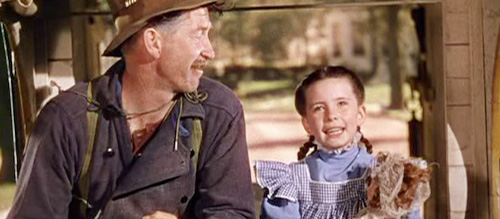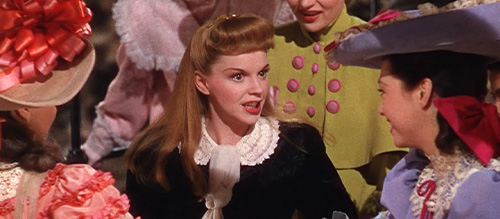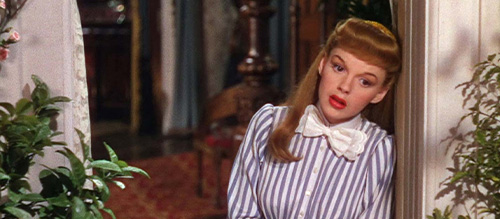There’s No Place like St. Louis at Christmas
The shift from Halloween to Christmas often feels sudden and, for most of us, far too soon. One day, it’s all black cats and cauldrons. The next – and by next, I mean, literally, Halloween night at 7pm – the orange and green candy is promptly replaced with candy canes and gingerbread-making kits. We all get into the holiday spirit at different times. For some, it’s when the Christmas tree goes up. For others, it’s when their favorite channel starts their Christmas Movie Marathon. For me, that moment – the moment when it really, and truly feels like Christmas – is when I hear Judy Garland sing “Have Yourself a Merry Little Christmas”, the song she made famous by singing it in my favorite holiday movie, Meet Me in St. Louis. And as we near the end of December and the holidays creep closer, I have to admit: I haven’t heard the song once.
Okay, that’s not quite true. I have heard versions of the song. It’s a staple of the season – a holiday classic – and everyone from Ella Fitzgerald to Phoebe Bridgers has sung it. A single Spotify search yields more than 600 results. But not once over the last month – and I work in retail, so I know what I’m talking about – have I heard Judy Garland’s voice. Even the lyrics are different. According to a U Discover Music article, when Frank Sinatra was preparing the song for his upcoming album, he told the composer and lyricist, Hugh Martin and Ralph Blaine, that the song’s lyrics were too depressing, remarking, “The name of my album is A Jolly Christmas. Do you think you could jolly up that line for me?”
The original version of “Have Yourself a Merry Little Christmas” is melancholy. There’s a certain sadness to it that’s only heightened by Judy’s achingly beautiful and haunting vocals. Maybe, out of context, it doesn’t make much sense to casual listeners. Maybe the emotional weight of the song gets lost in translation. But to me, it highlights just how strange Christmas time really is. Though it is often joyful, it can be filled with sadness and loneliness too. Meet Me in St. Louis somehow manages to capture the contradictions of the holidays and of life itself. The film, with Judy Garland’s stunning performance at the forefront, has always felt like Christmas to me.

Technically, Meet Me in St. Louis, based on Sally Benson’s “Kensington Stories” is not strictly a Christmas movie. The film takes place over the course of a whole year in the lives of the Smith family, beginning in the Fall of 1903 and ending in the Spring of 1904, at the Louisiana Purchase Exposition or simply The World’s Fair. Inspired by Sally Benson’s own family, the film focuses on the exploits of the four Smith daughters: Rose, Esther, Tootie and Agnes as they navigate growing up at the turn of a new century, in a city that is headed for, as their father Alonzo puts it, “a boom that will make your head swim.”
The film begins with almost every character, from Agnes to Grandpa, to Esther and Rose, singing some sort of variation of the title song. It’s a song that seemingly everyone knows, a song that is just as much a part of the city as the people who inhabit it. The lyrics reference a fair – The World’s Fair. Everyone is buzzing with anticipation, the pride they feel for their hometown clearly and loudly on display. While taking a ride on the ice wagon, the youngest daughter Tootie informs the driver, Mr. Neely, that it’s pronounced St. Louis not ‘Louie’, and that it’s the greatest city in the world. “Wasn’t I lucky to be born my favorite city?” she asks, dreamily.

The only person who seems far less enthusiastic, and visibly annoyed, with all the singing and talking about the World’s Fair is their father, Alonzo. After coming home from a long day at the office, Alonzo begs Esther and Rose to stop singing, declaring that the fair doesn’t open until next year. This is a key element of Alonzo’s character, which becomes important later as the main conflict of the film comes to light. Alonzo is set in his ways. He’s uncompromising with things such as how long he takes a bath, or what time dinner is. The excitement everyone feels about The World’s Fair seems lost on him. He’s too busy answering phone calls that aren’t for him to stop and take it all in. For him, life can happen anywhere. But for his family, their lives are bound to St. Louis.
Meet Me in St. Louis is layered with details. The whole film feels magical, from the set decoration to the costumes and the lighting. The main set of the film – the large, Victorian-style house the Smiths live in – is filled with texture and vibrant colors. It feels lived in yet carefully curated at the same time. The chaos is so effortlessly controlled, each frame composed to showcase every detail that makes up their lives. Director Vincente Minnelli worked closely with all the art departments to establish the visual style of the film. According to thejudyroom.com, Minnelli would also, on occasion, raid the MGM props closet himself to personally select items for the set dressing. Minnelli was a perfectionist, something Judy Garland allegedly loved making fun of him for, and he was essential in making Meet Me in St. Louis the success that it was. His love of rehearsing produced scenes that are perfectly paced, the rhythm and flow of the family’s dynamic both hilarious and heartwarming.

It’s hard to believe that hiring Vincente Minnelli to direct was considered a gamble for MGM at the time. But producer Arthur Freed, who would go on to write lyrics for Singin’ in the Rain, as well as win the Oscar for Best Picture twice, clearly knew what he was doing. Even Judy Garland, who didn’t even want to be in the film and actively tried to get out of it, was inspired by Minnelli’s commitment. According to their daughter, Liza Minnelli, speaking during an interview for the release of the special edition DVD released in 2004, Judy showed up to set and started saying all her lines with ‘a wink and a nod’. Minnelli, says Liza, yelled cut and told Judy that she had to believe what she was saying – that everything she did had to be the most important thing that has ever happened to her. “You have to care passionately,” Liza says her father told Judy, “or the audience won’t.”
Esther Smith is my favorite character Judy Garland played. And I say that as someone who watched The Wizard of Oz religiously as a child. But Esther captures my heart in a way no other performance does. She’s young, but also confident and witty. Judy’s voice, effortlessly sliding up and down the scale, introduced me to so many classic, musical standards, such as “The Boy Next Door” and “The Trolly Song,” which I ended up singing myself during my college musical theater audition. She had natural talent, that much is obvious, but her technique was astounding, every choice clear and purposeful. No song ever feels out of place or unnecessary, thanks to her ability to truly capture her audience. Time seems to stop when Judy sings.

One of my favorite moments of Esther’s is when she’s sitting at her vanity before their brother, Lon’s, going away party, and proclaims to Rose that she’s going to let John Truitt kiss her that night. “If we’re going to get married, I might as well start it,” Esther reasons. Rose scolds her and says that nice girls don’t let men kiss them until after they’re engaged because they don’t want the bloom rubbed off. “Personally,” Esther says as matter of fact, “I think I have too much bloom.” It’s so honest that I often wonder if it’s not Judy herself saying the line, begging MGM and the world at large to take her seriously, to see her as more than just the quirky best friend who never gets the guy. As more than just a little girl. She wanted to grow up on the screen, to be desirable and glamorous, just as all the other major contract players were allowed to do. And I don’t know what it was in the end that made Judy give such a stellar performance. I don’t if it was Vincente Minnelli’s gentle push or her new makeover or the fact that she was falling in love during the time of filming. All I do know is that Meet Me in St. Louis is the freest Judy ever was on screen. Esther radiates happiness and confidence because Judy herself was feeling, for maybe the first time, happy herself. Maybe it was all this combined. But what I do know for sure is that, to me – as a child and now as an adult – Judy was grown up. And desirable and beautiful. To me, she was everything.
One of the most enduring aspects of Meet Me in St. Louis is Esther’s relationship with her youngest sister, Tootie. Esther is nurturing to Tootie, often humoring her, and going along with her schemes. In the first part of the film, Tootie gets Esther to perform a song with her at Lon’s going away party. The result is a charming number called “Under the Bamboo Tree”, with Esther gently guiding Tootie through the whole thing. It’s sweet and sets up their relationship perfectly. In the middle part of the film, a vignette that takes place during Halloween, Esther’s love and protectiveness over Tootie are made apparent when Tootie lies and implies John Truitt hit her, prompting Esther to run over to his house and beat the shit out of him. It’s hilarious, but Esther’s feelings are clear: mess with my sister, mess with me. And when it turns out that Tootie was lying to cover up the horrifying – and downright criminal – antics of her and her friends, Esther goes over to apologize to John, and they share their first kiss. Although some at MGM felt this part of the film didn’t advance the plot and should be removed, it was Vincente Minnelli who made the case for keeping it in. Although on the surface it seems like this section of the film is a detour from the main action, it’s vital to the story. Because it’s this part of the film that clearly shows why this family loves this city so much. It’s in this part of the film that Esther and John truly start their romance. It’s the beginning of something. That’s why it feels like such a crushing blow when Alonzo comes home and tells his family that his law firm has offered him a new position in New York. Although some of the family is excited, it quickly becomes clear what this move would mean. Everyone would be ripped away from their friends. Agnes would have to say goodbye to her cat. Tootie would have to dig up all her dolls from the cemetery. And Esther would have to leave John. And although everything feels somber, the section of the film ends with Alonzo and their mother, Anna, singing and playing the piano, the kids sitting around listening and eating their Halloween dessert. Esther lovingly feeds Tootie spoonfuls of cake. Despite the move, at least they’ll all be together. And that’s a luxury we don’t always have.
The final part of the film takes place during Christmas. Tensions are high. First, John doesn’t pick up his tux in time, making him unable to take Esther to her last dance in St. Louis. Lon and Rose argue over the people they’re in love with, Warren Scheffield and Lucile Ballard, who are going to the dance with each other instead of with them. Their lives are in boxes, their home is bare. However, things quickly turn around. At the dance, Lucile Ballard suggests they all pair off with the people they really want to be with – Lon with Lucile and Rose with Warren. John finally shows up and spends the rest of the evening with Esther. It’s a wonderful moment underscored by the simple fact that come morning, the Smith family will be on their way to New York, leaving it all behind. And when John proposes to Esther, it quickly becomes clear that they’re too young, too newly in love to make such a decision. But the alternative is being miles away from each other and instead of facing that reality, Esther runs into the house, leaving John to sulk by the blue light of the moon.
Inside, Esther sings Tootie a lullaby to make her feel better. “Have Yourself a Merry Little Christmas” is the culmination of both the film and Esther’s arc as a character. She’s pined for John for so long, planned their lives together before she even knew he loved her back. And there she is, only moments after crying herself – wondering if her relationship will survive their move to New York. But Esther sets aside her own feelings and tries to comfort Tootie instead, giving her the greatest Christmas gift you could give to someone: just being there.
Judy’s performance of “Have Yourself a Merry Little Christmas” is both comforting and dripping with sadness and yearning. Framed by a windowpane, overlooking their snow-covered backyard, her eyes convey a depth of meaning she tries desperately to hide for the sake of her sister. It’s clear that when she sings, “Someday soon, we all will be together/if the fates allow/until then, we’ll have to muddle through/somehow,” she’s not just trying to convince Tootie that everything will be okay – she’s trying to convince herself. And while Frank Sinatra’s subtle lyric changes may make the song more optimistic, it loses the gentle longing and emotion of Judy’s version. Her version is timelier than ever, given the loss and grief we’ve all experienced over the past few years. Our collective yearning has never been greater.
And when the song doesn’t work, when Tootie runs out and begins to destroy the snow people – it’s Alonzo that witnesses this. Seeing his daughters embrace and Esther finally break down and start crying too, makes him realize that perhaps life is not just about being together. Maybe it isn’t enough. Seeing the snow-people, now clumps of snow on the ground, reminds him that maybe there are some things you can’t take with you. Maybe where we are is just as important as who we’re with. And that the places we live, live inside of us, and make us who we are. If The Wizard of Oz taught us that there’s no place like home, Meet Me in St. Louis taught us that, actually, there’s no place like St. Louis.
Alonzo takes a moment to reflect, wandering around the darkened home. Their furniture, much like their lives, is wrapped up and ready to be shipped off someplace else. The walls are bare, leaving only the outline of where pictures and paintings used to hang. Their house isn’t just a house, isn’t just walls and boards and wood. It’s a part of them. Maybe this is what it truly means to be home for the holidays. Home with your family and home in the place you feel safe.
In a comical and hilariously unaware speech to his family, Alonzo makes it clear they won’t be moving after all. St. Louis is far better than New York. “This is a great town,” he states. “The problem with you people is that you don’t appreciate it because it’s right under your noses.”
“You never feel like you’re making a classic,” Margaret O’Brien, who plays Tootie, said recently in an interview for TCM. “You’re making a movie and you hope it’s going to be good. But you don’t realize it’s going to go on for generations.” For me, Meet Me in St. Louis is a deeply rich film about love, both romantic and familial, and the ties that bind us. It’s an exploration of what it means to be home. And despite it not being the most commonly sung version, Judy’s “Have Yourself a Merry Little Christmas” will always be, for me, the definitive version. And during the holidays, when I’m stuck working eight-hour shifts, folding the same shirt over and over again, I’ll never stop hoping that when the song comes on, it’s Judy’s voice I hear.
By Margaret Roarty
You can support the author of this article, Margaret Roarty, at the following links:
Twitter – @ManicMezzo
Podcast Instagram – @justmythoughtsonitpod
Podcast Twitter – @thoughtsonitpod
Listen to Just My Thoughts on It – Anchor


Excellent essay on the film, the song, and the great Judy Garland. I don’t believe I’ve ever read an article that captures the film, the characters and the song’s importance on both the plot and the theme of being home for the holidays as I have in Margaret’s summarization here. It makes me want to watch Meet Me in St. Louis over and over again.